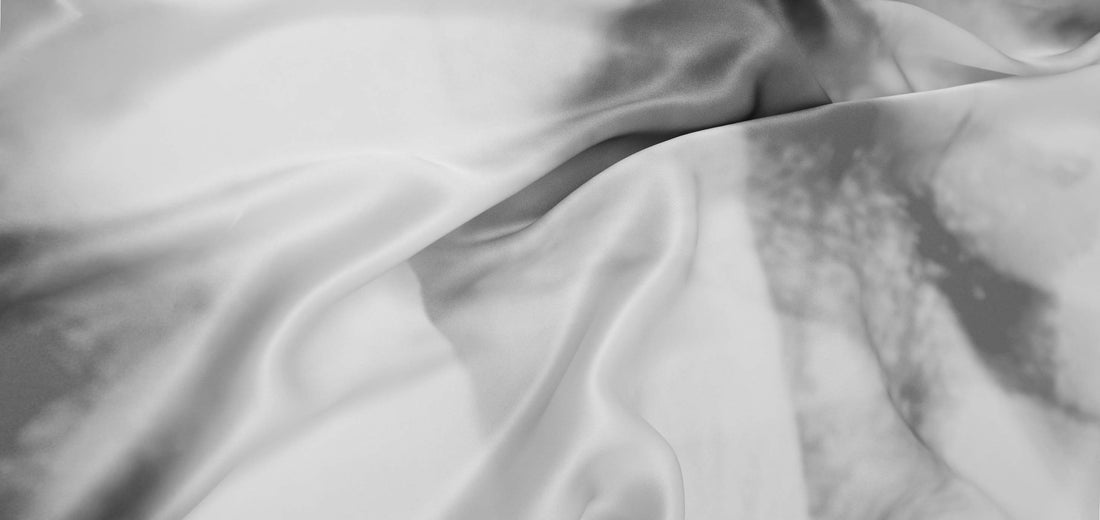Silk in the History of Art and Fashion
Share

For over 4,000 years, silk has captivated the world with its brilliance, fluidity, and refinement. This precious material, discovered in China, has traveled across continents to become a cornerstone of great civilizations — a medium for artistic expression and an enduring symbol of luxury. Even today, it continues to inspire creators and remains synonymous with sophistication. This article explores silk’s journey through art and fashion, from its ancient origins to its place in contemporary haute couture, and finally, to the vision of Essenty-Paris.
The Origins of Silk: Between Mystery and Legend
Legend has it that silk was discovered in China around 2700 BCE by Empress Leizu, wife of Emperor Huangdi. According to the tale, a silkworm cocoon fell into her cup of tea, revealing the first shimmering threads. This moment marked the beginning of a millennia-old story.
Soon, silk became a closely guarded state secret. Reserved for emperors and nobles, it was used to craft ceremonial garments and sacred banners. The Chinese perfected the art of weaving, turning silk into a textile as luxurious as it was mysterious.
Silk and the Silk Road: A Cultural Condu
Over time, silk crossed China’s borders and became the prized commodity of the legendary Silk Road. From Xi’an to Rome, it traveled through Central Asia, the Middle East, and Europe — carrying not just fabric, but ideas, techniques, and artistic influences.
This trade helped spread silk’s image in art: frescoes, tapestries, and paintings began depicting sumptuous silks. The fabric came to symbolize prestige, exoticism, and cultural power.
Silk in Art Through the Centuries
Silk is omnipresent in artistic imagery — from Byzantine frescoes and Renaissance portraits to Impressionist paintings. It often signifies wealth, power, and refinement.
In the Middle Ages
Silk fabrics imported from the Near East adorned kings, queens, and clergy. Medieval artists depicted silk in illuminated manuscripts and religious frescoes to symbolize the divine.
During the Renaissance
Italian and Flemish painters explored the play of light on silk to showcase their technical mastery. In court portraits, silk garments represented the wealth and prosperity of aristocratic families.
In the 19th and 20th Centuries
With the rise of modern painting, silk inspired artists with its textures and colors. Impressionists studied how light danced across its surface, while early 20th-century artists embraced it as a decorative and avant-garde medium.
Silk and the Rise of Fashion in Europe
From the 16th century onward, Lyon became the European capital of silk. The city supplied royal courts with sumptuous fabrics, helping establish French fashion as a symbol of refinement. Silk became the textile of choice for dresses, linings, and luxury accessories.
This industry fostered immense creativity among artisans and designers, who competed to produce floral, geometric, and art-inspired motifs. It was during this era that the modern silk scarf began to emerge.
Silk in Haute Couture
In the 20th century, silk became a cornerstone of haute couture. Dior, Chanel, Hermès, and many others used it to create dresses, blouses, and scarves. The silk scarf became an emblem of French luxury, worn by Hollywood icons such as Audrey Hepburn and Grace Kelly.
Designers treated silk as a blank canvas for creativity — experimenting with floral prints, geometric patterns, and artistic inspirations. The silk scarf thus became a bridge between art and fashion, a wearable work of art.
👉 At Essenty-Paris, this vision continues through unique creations printed on French silk and finished by hand.
Silk and Major Artistic Movements
Throughout history, artistic movements have influenced silk patterns and uses:
- Art Nouveau: floral motifs, arabesques, and sinuous lines in silk prints.
- Art Deco: geometric precision and graphic elegance.
- Pop Art: bold, colorful, and expressive designs.
- Contemporary Art: collaborations between designers and artists producing limited-edition silk scarves.
Silk has always served as a canvas for art, allowing creativity to travel and giving fashion a cultural dimension.
Silk Today: Between Heritage and Modernity
Silk continues to hold a central place in contemporary fashion. Designers reinterpret it through innovative cuts, prints, and combinations. Luxury houses use it to reaffirm their commitment to craftsmanship and tradition.
Beyond fashion, silk retains its cultural aura — symbolizing rarity, elegance, and creativity. Every silk scarf carries a story, an artistic heritage that transcends fleeting trends.
Essenty-Paris : Extending Silk’s Legacy
At Essenty-Paris, we see silk as an artistic language. Our scarves, designed in France and produced in limited editions, carry forward this timeless heritage. Each piece is conceived as a textile artwork linking past and present.
Our collections, Quintessence, Metamorphosis, Wanderlust and Flowstone embody our desire to unite art and fashion. Inspired by culture, travel, and timeless elegance, they restore silk to its rightful place in the world of contemporary luxury.
Conclusion: Silk — A Thread Between Art and Fashion
From its ancient Chinese origins to its modern role in haute couture, silk has always symbolized prestige and creativity. It has fueled the imagination of artists, inspired designers, and adorned icons. Today, it remains a pillar of luxury fashion — an inseparable link between art and elegance.
When you choose an Essenty-Paris silk scarf, you’re not merely wearing an accessory — you’re embracing a millennia-old story, an artistic legacy, and a contemporary vision of luxury.
👉 Explore our silk scarf collections today and become part of this timeless story.
